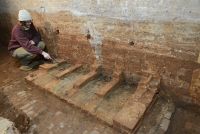A Kitchen for James Hemings
Yet another story of a recent rediscovery comes from Monticello, where archeologists dug under a part of Thomas Jefferson’s estate where bathrooms had been built for visitors during the Bicentennial.
Megan Gannon of Live Science reports on the deep history of what they found:
In 1793 Jefferson and Hemings made an unusual deal: the cook would keep working at Monticello until he had trained his younger brother in that kitchen, and then become free. Peter Hemings in turn was the Monticello chef from 1796 to 1809 before becoming the estate’s brewer after President Jefferson brought Edith Fossett home from Washington, D.C. to those stew stoves.
Megan Gannon of Live Science reports on the deep history of what they found:
And, finally, underneath the dirt, the team found the original brick floor of the kitchen where enslaved cooks working in the cellar would have made food to be delivered to the Jeffersons in the top story. The remains of a fireplace and the foundations of four stew stoves were also intact. . . .Jefferson liked Hemings’s cooking so much that he took the younger man to Philadelphia when he started to work in the federal government, and even to New England when he and James Madison went on a sightseeing and party-building tour.
Those four foundational compartments of the stew stoves would have been the clean-out, where the ash would have fallen. The actual stoves would have been about waist-high, Ptacek said. Each stove would have had a small hole for hot coals from the fireplace. An iron trivet would have gone above the coals to hold pans. Stew stoves were essential for making dishes that required slow heating and multiple pans. The setup was the equivalent of a modern stovetop, but it was uncommon in North America at the time because it required special training to use.
Stew stoves first became popular in 17th-century France, Neiman said. Previously, during the Renaissance, the cuisine of the rich in Europe involved heavy use of spices imported from far-flung parts of the world. But that changed when spice prices plummeted after European powers took control of resources and trade routes during colonial expansion across the Atlantic and into Asia.
“All the sudden, highly spiced foods are no longer the way you signal you’re wealthy,” Neiman said.
The new type of cuisine perfected by French aristocrats as a form of status competition was extremely labor intensive. Their “sumptuous multicourse meals,” Neiman, said, involved fresh veggies, fresh meats and slowly heated sauces based on cream, butter and eggs, without a lot of spice so that the natural flavors of the food could shine through.
Jefferson had an affinity for French cooking, and he likely first encountered stew stoves during his education at the College of William and Mary in Williamsburg, Virginia. He was a frequent guest at the colonial governor’s palace in Williamsburg, which was one of the few places to have stew stoves at the time.
But Jefferson must have become much more familiar with this style of cooking when he served as the U.S. minister to France from 1784 to 1789. As soon as Jefferson took this diplomatic position, he wrote to his future secretary that he wanted to take then-19-year-old [James] Hemings to France “for a particular purpose,” which turned out to be having him trained in the art of French cooking. The archaeologists at Monticello think the stew stoves were likely part of a kitchen upgrade Jefferson made when he returned from Paris.
In 1793 Jefferson and Hemings made an unusual deal: the cook would keep working at Monticello until he had trained his younger brother in that kitchen, and then become free. Peter Hemings in turn was the Monticello chef from 1796 to 1809 before becoming the estate’s brewer after President Jefferson brought Edith Fossett home from Washington, D.C. to those stew stoves.


No comments:
Post a Comment